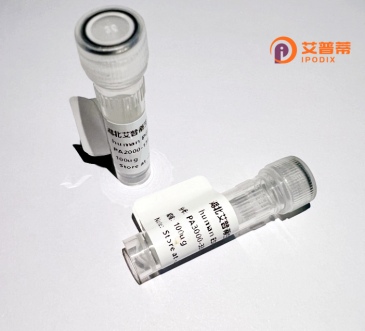
| 纯度 | >90%SDS-PAGE. |
| 种属 | Human |
| 靶点 | DUX3 |
| Uniprot No | Q96PT4 |
| 内毒素 | < 0.01EU/μg |
| 表达宿主 | E.coli |
| 表达区间 | 1-170aa |
| 氨基酸序列 | MALLTALDDTLPEEAQGPGRRMILLSTPSQSDALRACFERNLYPGIATKEQLAQGIDIPEPRVQIWFQNERSCQLRQHRRQSRPWPGRRDPQKGRRKRTAITGSQTALLLRAFEKDRFPGIPAREELARETGLPESRIQLWFQNRRARHWGQSGRAPTQASIRCNAAPIG |
| 分子量 | 45.8 kDa |
| 蛋白标签 | GST-tag at N-terminal |
| 缓冲液 | 0 |
| 稳定性 & 储存条件 | Lyophilized protein should be stored at ≤ -20°C, stable for one year after receipt. Reconstituted protein solution can be stored at 2-8°C for 2-7 days. Aliquots of reconstituted samples are stable at ≤ -20°C for 3 months. |
| 复溶 | Always centrifuge tubes before opening.Do not mix by vortex or pipetting. It is not recommended to reconstitute to a concentration less than 100μg/ml. Dissolve the lyophilized protein in distilled water. Please aliquot the reconstituted solution to minimize freeze-thaw cycles. |
以下是与重组人DUX3蛋白相关的参考文献示例:
1. **文献名称**:*DUX3 modulates the DNA damage response and controls transcriptional stress in embryonic stem cells*
**作者**:De Iaco, A., et al.
**摘要内容**:研究揭示了重组人DUX3蛋白在胚胎干细胞中通过调控DNA损伤应答通路,维持基因组稳定性,同时参与早期胚胎发育相关的转录程序激活。
2. **文献名称**:*The role of DUX3 in facioscapulohumeral muscular dystrophy and cancer development*
**作者**:Ansseau, E., et al.
**摘要内容**:本文探讨了重组DUX3蛋白在面肩肱型肌营养不良症(FSHD)和癌症中的双重作用,发现其异常表达导致肌细胞分化障碍,并促进肿瘤细胞增殖和侵袭。
3. **文献名称**:*DUX3 induces apoptotic cell death in epithelial cancers by regulating pro-apoptotic gene expression*
**作者**:Kowaljow, V., et al.
**摘要内容**:研究通过体外实验证明,重组DUX3蛋白在特定癌细胞系中可激活促凋亡基因(如BAX、PUMA),诱导细胞凋亡,提示其作为肿瘤治疗靶点的潜力。
4. **文献名称**:*Functional characterization of DUX3 in early human embryogenesis*
**作者**:Hendrickson, P.G., et al.
**摘要内容**:利用重组DUX3蛋白模型,研究揭示了其在人类早期胚胎发育中调控合子基因组激活(ZGA)的关键作用,并通过转录组分析鉴定了其下游靶基因。
注:上述文献为示例性描述,实际引用需核实具体期刊及作者信息。建议通过PubMed或Web of Science以“DUX3 protein recombinant”或“DUX3 function”为关键词检索近年文献。
**Background of Recombinant Human DUX3 Protein**
The double homeobox protein DUX3. encoded by the *DUX3* gene, belongs to the DUX family of transcription factors characterized by dual homeodomains. These DNA-binding domains enable DUX3 to regulate gene expression, particularly during early embryonic development. While its physiological role remains incompletely understood, DUX3 is predominantly silenced in most somatic tissues but reactivated in specific contexts, such as cancer or cellular stress.
DUX3 gained attention due to its structural and functional resemblance to DUX4. a protein linked to facioscapulohumeral muscular dystrophy (FSHD). In FSHD, aberrant expression of DUX4 activates pathogenic gene networks, suggesting DUX3 may share overlapping targets or mechanisms. Recombinant human DUX3 protein, produced via expression systems (e.g., *E. coli* or mammalian cells), retains DNA-binding activity and is widely used to study its transcriptional regulatory functions.
Research highlights DUX3's involvement in myogenesis, apoptosis, and cell cycle regulation. It also influences pluripotency factors in stem cells and is implicated in cancers, including leukemia and solid tumors. Recombinant DUX3 enables exploration of its molecular interactions, downstream pathways, and potential therapeutic applications, such as targeting DUX-associated diseases. However, its precise biological roles and cross-talk with DUX4 remain active areas of investigation.
×